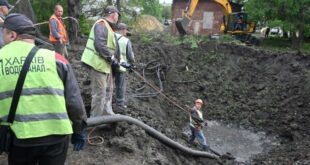The streets of Civitacampomarano are filled with murals hidden in stone alleys and under ancient archways
If there's one thing not lacking in Italy, it's affordable real estate.
Thousands of stunningly picturesque towns and villages — in the mountains, hilltops and seaside — sit half-empty, as the country's declining birth rate and prolonged economic crisis have led to an exodus of people from non-urban areas, and young people from Italy itself.
There has also been no shortage of creative attempts to draw people back: from one-euro homes and the waiving of some taxes for foreign buyers, to offers of a basic monthly income for a year or two for those who open small businesses.
These desperate acts of enticement for foreigners and urban northerners — anyone! — to purchase and renovate rundown homes in near-abandoned towns have, for many communities, been the last gasp of hope in a steady slide toward ghost-town status.
But not all the sparsely inhabited Italian towns and villages are dangling financial incentives to lure new inhabitants.
Civitacampomarano, a small town in the southern region of Molise, located a three-hour drive southeast of Rome, is tapping into art instead, with defiant, urban roots to breathe new life into its centuries-old stone structures.

"Before street art came here, it was just one of thousands of semi-empty towns throughout Italy," said Ylenia Carelli, 46, a main organizer of the mural festival in Civitacampomarano, called CVTÀ Street Fest.
"Art has been the determining factor in revitalizing this town."
The town's oldest section is a narrow wedge of mostly crumbling stone structures, sliced lengthwise by two laneways. It sits atop a dizzyingly steep precipice with a velvety skirt of lush vegetation flowing around it.
Civitacampomarano's present-day population is 300, down from a peak of 3,000 in the 1970s. The decimation mirrors that of its surrounding region: Molise is Italy's second-smallest region, home to fewer than 300,000 people — with so few inhabitants that Italians jokingly call it "Nolise."
"All of these houses were full," said Carelli, referring to when she was a child in the '70s. "When you walked down this laneway, all the doors were open, with people coming and going. Now the doors are closed or missing."
Post-war emigration from the town — with some residents leaving for South and North America — picked up pace in the 1980s, when inhabitants moved to northern Italy or the nearby Adriatic coast for factory jobs and life drained from the town.
Carelli, one of the few to stay, struggled for years to put on the annual sagra, or village fair.
Then in 2015, while watching TV one evening, she caught a profile of an artist from Rome named Alice Pasquini, whose subtly unnerving depictions of aloof and independent-looking women spoke to Carelli. On a whim, she sent the artist an email, asking her if she'd consider coming to Civitacampomarano to paint.
"I was in New York painting a mural when I received the email," said Alice Pasquini, a self-described contextual artist, with murals around the world. "It said, 'I have a dream, I know you will never answer, I saw you on TV, I would love you to paint a wall here.'"
But Pasquini did respond.
In a strange coincidence, her grandfather had been the town's doctor, reverentially known as Don Ciccio. She'd spent her childhood summers in the area and knew Civita, as locals call the town, well.
Pasquini went on to not just paint murals in Civita, but to help Carelli and fellow townsperson Barbara Manuele launch a street art festival, which Pasquini now art directs.
"I ask myself, 'How you do a festival with no restaurant, no B&B, no nothing?'" she said of the initiative. "But then I say, 'We have people!'"
A large network of artist friends, who came and camped out in the abandoned homes, including her grandparents', and joined her in painting the village walls.

Seven years later, Civitacampomarano is an open-air museum where around every corner, a work of art that startles, disturbs and delights. Thousands of visitors come each year to see the art — most during a weekend festival in June. They move through the stone alleys and under ancient archways in a kind of street-art treasure hunt.
And as part of the festival, top global street artists now come here to paint. This year, that included British artist Helen Bur, South African artist Ellena Lourens, American artist Dan Witz and Pakistani-German artist Jasmin Siddiqui.
Siddiqui, who goes by the name Hera, half of the artist duo Herakut, covered a towering stone wall with a scrappy, wild cat-girl — an homage to the cat eyes lit up by her car's headlights when she arrived.
"This line of cats on the street was the first sign of life, so I thought, 'OK, they rule. They rule this place!'" she said.
The artist, 42, from Frankfurt, has painted more than 20 commissions around the world — everywhere from thriving urban neighbourhoods in Berlin and New York to refugee camps.
"As I was painting, this girl came up and really wanted to talk to me, and pulled out all the English she knew," she said, speaking of the importance of getting to know the place through its people. "I asked her what else she thought the cat needed and she said, "It's so obvious, the cat needs milk!'"
Hera went on to add the bottle of milk, a trophy for a town that has resisted despite the odds.
"This festival has been a profound experience," said New York artist Dan Witz, a seasoned veteran of street-art festivals. "It's not about promoting real estate, but about love for a place."
This year, he painted a large mural in the upper town called Peace Out, about grieving, and 10 smaller images of children peering out behind grates.

They're part of his Is It Safe? series, initially commissioned by Amnesty International for people imprisoned without habeas corpus rights. During the Trump presidency, when the U.S. administration began separating migrant children from their parents and putting them in cages, it evolved to include children.
Many are almost camouflaged in doorways, making them easy to miss.
"You'll see one or two, but knowing there are 10, you'll keep your eyes open, which is a message I like to give," he said. "Keep your eyes open and you'll never know what you'll see."
Along with the thousands that now visit Civitacampomarano are some 30 new foreign residents who now call the town home — at least for part of the year.
Among them are several Canadians, including Victoria Muzychuk, 57, who works as a recruiter for Saskatchewan Polytechnic in Regina and plans on moving to Civita full time in a few years, when she'll teach English as a second language remotely, as well as her mother tongue, Ukrainian.
A former world traveller, Muzychuk bought her home for $40,000, including notary and real estate fees, during the COVID lockdowns of 2020, after seeing it advertised online.
"I discovered the art when I was looking at photos of the village," she said. "Then when I came for the first time, the local people took me around and explained each mural. This art isn't just there to add colour, each mural has a story behind it. It's meaningful."
Since then, she's volunteered in the tourist booth to help English-speaking visitors, saying it's important to her to be an active part of the community and integrate not just with fellow ex-pats, but local Italians, too.
"They remind me of the people in Saskatchewan," she said. "They're hard-working and very, very helpful."
American therapist Jody Olmstead, who works remotely from a small stone house with a breathtaking valley view, says it was the street art that drew her to Civita, too, and the people that convinced her to stay.
"I feel very inspired by this town," she said both of its inhabitants and the art. "The people are very connected. And the food and drink. Every aspect is about connection."
Maria Lucia Di Paolo, a lawyer who works in Florence, but comes back home to Civita on weekends and holidays, says she and her fellow villagers feel just as grateful for the new arrivals.
"For years, the only community events here have been funerals. Never a wedding, never a birth," said Di Paolo. "Now there's new life and joy."
ABOUT THE AUTHOR

Rome correspondent
Megan Williams has been covering all things Italian, from politics and the Vatican, to food and culture, to the plight of migrants in the Mediterranean, for more than two decades. Based in Rome, Megan has also told stories from other parts of Europe and the world and won many international prizes for her reporting, including a James Beard Award. Her radio documentaries can be heard on Ideas and The Current. Megan is also a regular guest host on CBC national radio shows.
*****
Credit belongs to : www.cbc.ca
 MaharlikaNews | Canada Leading Online Filipino Newspaper Portal The No. 1 most engaged information website for Filipino – Canadian in Canada. MaharlikaNews.com received almost a quarter a million visitors in 2020.
MaharlikaNews | Canada Leading Online Filipino Newspaper Portal The No. 1 most engaged information website for Filipino – Canadian in Canada. MaharlikaNews.com received almost a quarter a million visitors in 2020.







